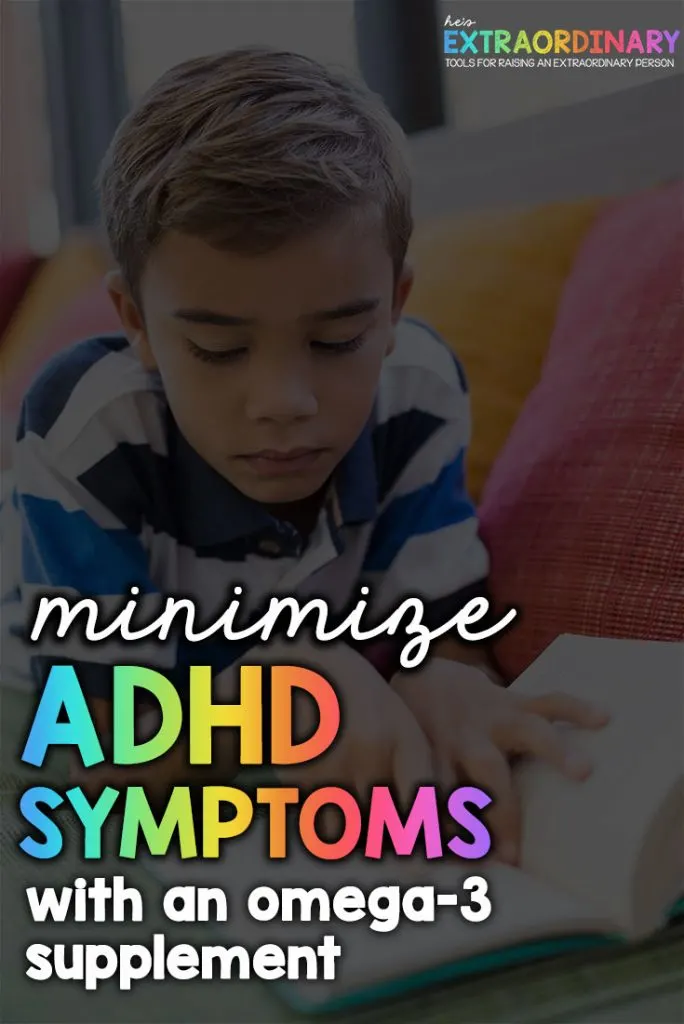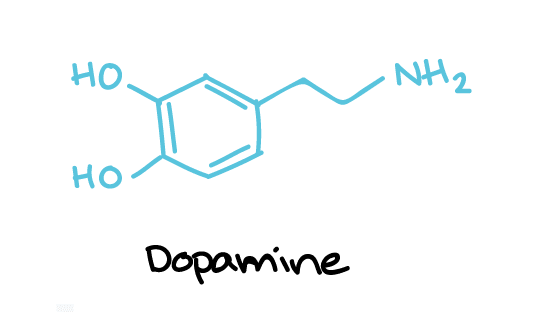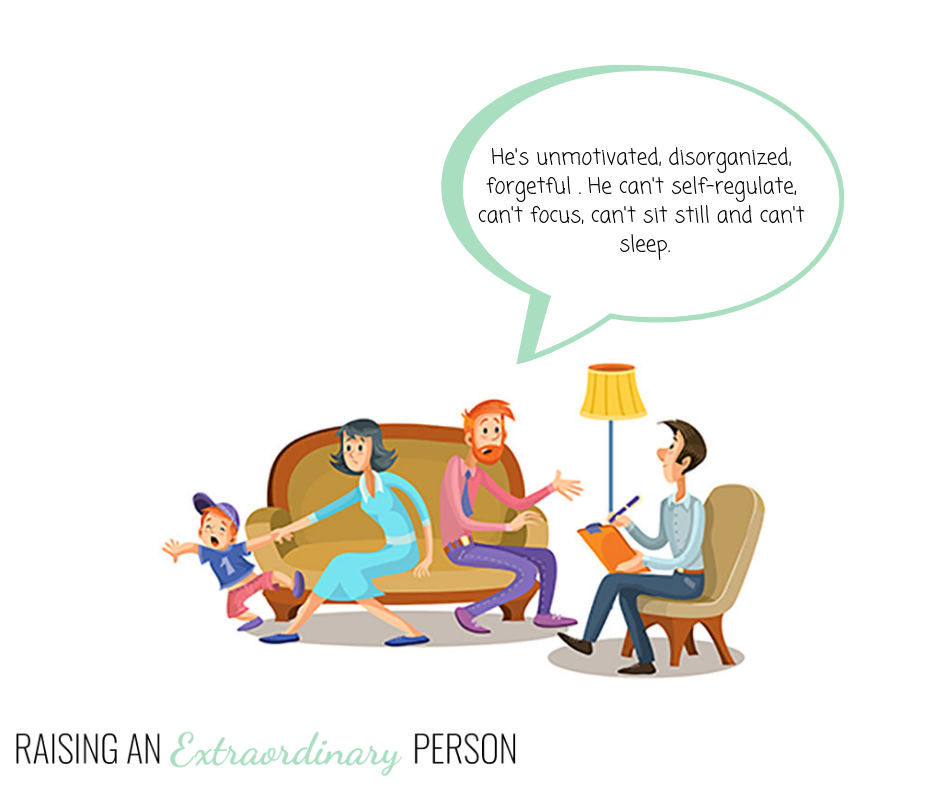What’s inside this article: An explanation of how ADHD medications work to increase the level of dopamine in the brain, and how omega-3 is required for our body’s to create dopamine. Plus a look at which omega-3 supplements are the best for ADHD.
Disclaimer: This post contains affiliate links.
Taking the right omega-3 supplement can drastically improve your child’s ADHD symptoms. I’m going to explain the link between this fatty acid and the ADHD brain.
Omega-3 fatty acids (DHA and EPA) are essential fats because unlike other types of fat, our body can’t make omega-3s from scratch. We must include them in our diets.
Cell membranes throughout our bodies use omega-3s. Which makes them a critical component for cell receptors to function.
So what are the benefits of Omega 3 supplements and why does this become so important for kids with ADHD?
Omega 3 Supplements for ADHD – The Link Explained

I hope I don’t lose you over the next few paragraphs. Bear with me while I do my best to explain this as simply as I can.
The Link Is Dopamine

Dopamine is a neurotransmitter in our brain that helps carry messages from one neuron to the next.
Basically, it delivers messages from one part of our brain to another, and to other parts of our bodies through our nervous
Dopamine also helps us control our emotions and motivation to work towards a reward because it is used to activate our reward pathway.
Without adequate omega-3 fatty acids in our diet, our bodies cannot produce enough dopamine.
ADHD is linked to dopamine deficiency. (Source)
How ADHD Medication Works
Depending on the actual medication, stimulants work in one of two ways.
They either increase dopamine production in the brain, or they block the reuptake of dopamine.
Stimulants that work as dopamine reuptake inhibitors slow down our body’s process of absorbing or breaking down dopamine, so the effect is there is more present.
I’m trying to keep this as simple as possible without going into the science behind this so it’s easy to understand. If you’d like to read more in-depth about how stimulants work you can visit the NIH website here.
So the goal of ADHD medications is to increase dopamine levels in the brain, thus improving concentration and reducing the negative symptoms associated with ADHD.
However, it’s critical that your child’s body is not deficient of omega-3 so their body can actually produce adequate levels of dopamine in the first place.
Current Research on Omega-3 & ADHD
The AAP published an article in their journal, Pediatrics, after conducting a double-blind study in which 40% of parents noted some improvement in symptoms, while 15% noticed a significant improvement.
Omega 3 supplements can work alongside ADHD medication, but also on its own if you do not medicate. (Always consult a doctor before making medication changes)
But what this all means is, even if your child is on medication for ADHD, if they have an omega-3 deficiency, the medication may not work to its full potential because their body needs these essential fats to produce dopamine in the first place.
Related: Printable ADHD Symptom Monitoring Log
Dopamine Deficiency
Thinking about the brain, imagine dopamine as little messengers – carrying messages across your brain, from one cell to the next, then delivering them to where they need to go.
For every single thought, feeling, or action you complete – neurotransmitters, including dopamine, fire a signal through connected neurons in your brain to form a functional circuit.
This is how your brain is wired.
As your brain processes everything that is happening around you, it is creating associations and forming circuits.
So, imagine if you bring your toddler a chocolate bar when you get home from work. Don’t be surprised if she asks for a chocolate bar again the next time you come home from work.
Why?
Her brain created an association between you returning from work and her getting chocolate, so a ping was sent through that circuit again, reminding her of the
This is also why a certain smell, song, or location may suddenly remind you of a cherished memory, traumatic experience, or something that happened in your childhood.
Neuropsychologist, Donald Hebb, explains this phenomenon with the phrase “Neurons that fire together, wire together”.
Related: 4 Natural Treatments for ADHD That Are Backed By Science
Signs of dopamine deficiency
Now, back to dopamine deficiency – if your brain doesn’t have enough dopamine to work efficiently when that “ping” happens to shoot a message across the circuit … it loses momentum.
It might take too long to reach the end of the circuit, or never make it there at all.
The signs of dopamine deficiency may include:
- Poor concentration
- Memory loss
- Forgetfulness
- Mood swings
- Inability to focus
- Anxiety
- Lack of motivation / not responding to reward systems
- Poor self-awareness
Considering these signs are all common symptoms of ADHD as well, it’s clear why low dopamine would exasperate ADHD symptoms.

My Personal Experience
My son has a lot of trouble staying motivated and at times it seems like even his favorite activities and rewards are meaningless to him. During school, this issue came up time and time again with staff while working on his IPP.
It wouldn’t matter what reward he had the chance to work for, sometimes he just did not care. I’m sure others can relate to this. Dopamine is the chemical that makes us feel motivated.
My son’s executive functions are quite a bit behind his peers, we found out from testing he’s in,
There are connections between all of these things. Everything needs to be in sync in order to have a well-regulated, focused child that’s ready to learn.
Foods With High Omega-3 Content
Many kids are picky eaters and any parent with an ASD child knows how hard it can be to make their child eat a well-balanced diet.
Trust me, my child is no exception and his diet isn’t very varied. He tends to prefer processed foods and carbohydrates.
Some foods with high omega-3 include:
- Flaxseeds
- Fatty Fish
- Spinach
- Walnuts
- Chia seeds
- Soybeans
My son won’t actually eat any of that. So I’m almost certain that he doesn’t get enough DHA or EPA from his regular diet (I’m sure I don’t either, which is why I started taking a supplement, too. )
Did you know an omega-3 supplement can help you have more energy, and lessen that groggy feeling you have when you wake up in the morning?
Can You Add Omega-3 supplements to food?
Yes, you can.
There are a few ways to hide omega-3 in your child’s food and these can work even if they’re a picky eater.
Flex Seed
One way is with ground flaxseed. I only purchase Bob’s Redmill brand, which is available on Amazon and in most grocery stores in their health food aisle. It’s flavorless and odorless.
The texture is pretty undetectable in most foods. I throw a tablespoon into food as I’m cooking and no
It really doesn’t change the flavor, trust me. My son would notice a pinch of extra garlic in his chili, there’s normally no fooling his taste buds.
Flaxseeds are great, a bag lasts forever and it’s good for a month if you keep it refrigerated. I keep mine in a container in the fridge once it’s opened.
They’re also super high in fiber and great if your child deals with constipation.
But, I’ve read your body doesn’t absorb the omega-3 as well as it does from fish oils. So, flaxseed alone likely won’t be
Liquid Omega-3 Supplements
You can mix liquid supplements with your child’s food.
Your child might not drink a liquid omega-3, even if it’s flavored. But there are a few foods that a liquid supplement mixes with really well.
Give one of these a try:
Peanut Butter
Peanut butter is oily anyways, from the oil of the peanuts. If your child likes peanut butter, it’s easy to stir an omega-3 oil into their peanut butter without changing the texture, consistency, or flavor.
Then just use it on toast, or in a sandwich.
Smoothies
If your child doesn’t like peanut butter, another option is adding the omega-3 oil to a smoothie.
In regular beverages, the oil floats to the top and you can see it, but it doesn’t do this in a thick smoothie.
Simply use your favorite smoothie recipe and add in the oil. I like to use strawberry banana juice, frozen strawberries, a fresh banana, and some vanilla greek yogurt.
Popsicles
Popsicles are another way to hide fish oil in your child’s food.
You can make your own popsicles with your child’s favorite fruit juice, or with the smoothie recipe.
Measure out the omega-3 first and put it inside each popsicle mold to ensure the right amount goes in each. Then add in the juice and freeze.
Be careful with these ones in your freezer because if any of the liquid spills it’s very oily and hard to clean up. (I learned this the hard way)
Finding The Right Omega 3 Supplements for ADHD

The best way to get enough DHA and EPA into your child’s diet is with an Omega-3 supplement. You need to make sure you find the right supplement.
The average omega-3 to
So you need to look for a supplement that is low in omega-6.
Plus, with a picky eater you also need to choose a supplement they will actually take. A lot of the gummies have a fishy taste and the liquid, even when well flavored, has an unpleasant texture.
First of all, don’t use a multivitamin as your source of omega-3. They are great for other vitamins but will contain much less omega-3 compared to a regular omega-3 supplement, so it won’t supply enough of this essential fat.
Gummy Supplements
I recommend a
It was tricky for me to find one that my son liked at first.
We first bought some Disney Finding Dory gummies at the grocery store. They had the right ratio of Omega-3 to Omega-6 and promised a great taste, but my son wouldn’t eat them.
They almost had this film or coating over them and the fishy aftertaste.
I also tried a store brand version which he didn’t like either.
The supplement that we currently use is Jamieson Omega-3 Gummies
My son enjoys eating these and always looks forward to having them each day. I can only wish we’d found them sooner. His “fishy gummies”. They’re the best tasting ones we’ve found.
Liquid Supplements
If you are looking for an oil, AHAlife carries a high quality pure omega-3 liquid for kids called Super Hero by Bare Biology T
his is a high-quality product containing the most omega-3 on the market. One drop a day is all that’s needed so these drops should last about 9 months.
Recap:
Here’s a quick recap:
- There is a strong link between ADHD and dopamine deficiency
- The body needs omega-3 fatty acids to produce dopamine
- 40% of parents noticed an improvement in ADHD symptoms after 3 months of taking omega-3
- There are many different types of omega-3 supplements. Our preferred brand is Jamieson

Natural ADHD Treatments - 4 Ways To Improve ADHD Without Medication
Thursday 24th of October 2019
[…] writing about the benefits of Omega-3 Supplements for common ADHD symptoms, I started doing a lot of research about other natural ADHD treatments. My […]
List of ADHD Medication for Kids · ADHD Resources for Parents
Wednesday 28th of August 2019
[…] How Omega-3 Helps Children with ADHD […]